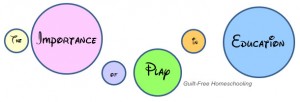[This article was written by Jennifer (Morrison) Leonhard: Guilt-Free daughter and homeschool graduate.]
Society spends years conforming our minds, teaching us to follow certain conventions and rules, and then once we reach college and business, we are asked to be “out of the box thinkers.” I turned to my brother for inspiration at this point. My brother has never been accused of being “in the box” unless it was a large cardboard box, wrapped as a Christmas present during a white elephant gift exchange. (Yes, he really did that.)
In math class, when presented with a hexagon and asked to “Name this figure,” he simply wrote “Bob.” When Mom asked what direction he would be facing if he went out the front door, walked 3 steps and turned right, took 3 steps, then turned right again, took 3 steps and turned right again, he said, “Forward!” By nature I am more of a conformist, striving to give the answer that was expected of me, and when faced with an “out of the box” question, I was often lost. Given no absolute and no example upon which to base my answers, I didn’t know where to look and often called my brother from college to see what his answer would be. After an hour or so of brainstorming, I could find a direction that suited me for forming my own thoughts.
Surprisingly though, I have often been considered by my peers as a bit out of the box. For the past few years, I have dressed in costume for work during the holiday season. It started when I worked in a commission environment (selling fine jewelry) and had to find a way to gain attention and get customers to talk to me. Dressing in a Santa hat and curly toed shoes with bells on the ends made customers want to greet me, instead of shying away when I greeted them. Getting the initial greeting with the customer was the hard part — after that I could gain the information I needed to learn who they were shopping for and what that person might like in a gift. My costumes prompted the customers to speak to me first.
Last year we had too much Halloween inventory at our retail store, and it wasn’t moving out the door fast enough. I started dressing in costumes, and children would beg their parents for a costume: after all, that girl over there (me) is dressed up, and it isn’t Halloween yet! It worked. I started coming up with as many costumes as I could, digging through our old dress-up box to come up with ideas. Many costumes were based on a single hat and accessorized to fit the theme. A witch’s hat turned an ordinary black dress, green tights, and green eye shadow into a complete character. The same idea worked with an inexpensive pirate’s hat and a striped shirt, dark eyeliner, one hoop earring, and a gold blazer. Everyone at work asked where I got these elaborate costumes, but most of them were things I normally wore to work any other day, but they were just combined differently to go with a specific hat. It seems simple enough when explained, but my coworkers simply can’t get over each costume I wear. They laugh at my courage to wear a costume to work, since many are not planning to wear a costume on Halloween, but I’ve been wearing costumes every day for weeks.
I don’t know exactly what factors made my brother and me the way we are, but I do know that we were encouraged to have an imagination much bigger than ourselves. We drew Dr. Seuss characters with chalk on the sidewalk and tried to create Seuss-like characters of our own. Mom had wanted to be an astronaut when she grew up, and that same desire to shoot for the moon was passed on to my brother and me.
When my brother and I were growing up, Mom would ask us questions that would get us to think situations through. Along with asking us simpler questions, like what sounds certain animals made, she would ask us more intriguing questions, such as how would we get our shoes tied if we had a broken arm. She asked questions that would get us to anticipate the future before it happened, and consider how different variables could alter the outcome. We were encouraged to look at questions from different angles, to experiment to see what happened, and to have the imagination to believe anything was possible.
Mom created new games using parts from the other games we had — usually to teach us something. I hated spelling, but using Scrabble tiles to form my spelling words made the subject a little easier to grasp. Math was more fun when it involved a scavenger hunt for us and a friend. In fact, Mom always called math a puzzle. She enjoyed algebra, and as annoying as that was sometimes, she taught us how to see it as a puzzle, too. Mom used her math skills to scale down the solar system to the size of our block — the sun was as wide as our street, and we drew its outline with chalk right there in the middle of the street, and then we mapped out the planets to scale, too. Seeing how far the planets would be from each other if the sun would fit on our street helped us to imagine how far away from each other they must be in real life.
I’m not especially talented, I am a horrible artist, the musical talent went to my brother, and I wouldn’t make a good actress. I’m also not the homeschooler who is likely to be featured on the cover of a magazine. I enjoy math, but it doesn’t come easily to me. However, I did learn to visualize things, whether possible or not, in order to come up with solutions and decide on the best one. Although a lot of my homeschooling came from books due to my love of reading, some of the most memorable parts were when our family got out of the textbooks, out of the classroom, and out of the box.





 Guilt-Free Homeschooling is the creation of Carolyn Morrison and her daughter, Jennifer Leonhard. After serious disappointments with public school, Carolyn spent the next 11 years homeschooling her two children, from elementary to high school graduation and college admission. Refusing to force new homeschooling families to re-invent the wheel, Carolyn and Jennifer now share their encouragement, support, tips, and tricks, filling their blog with "all the answers we were looking for as a new-to-homeschooling family" and making this website a valuable resource for parents, not just a daily journal. Guilt-Free Homeschooling -- Equipping Parents for Homeschooling Success!
Guilt-Free Homeschooling is the creation of Carolyn Morrison and her daughter, Jennifer Leonhard. After serious disappointments with public school, Carolyn spent the next 11 years homeschooling her two children, from elementary to high school graduation and college admission. Refusing to force new homeschooling families to re-invent the wheel, Carolyn and Jennifer now share their encouragement, support, tips, and tricks, filling their blog with "all the answers we were looking for as a new-to-homeschooling family" and making this website a valuable resource for parents, not just a daily journal. Guilt-Free Homeschooling -- Equipping Parents for Homeschooling Success!

Recent Comments